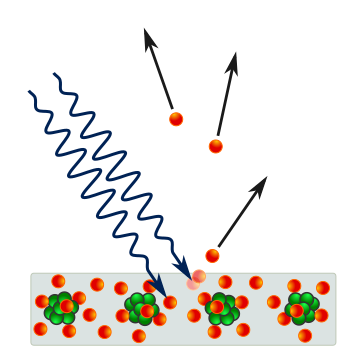
This week, one of my students challenged my understanding of the photoelectric effect… Basically, he didn’t think that the current produced by the photoelectric effect should be affected by the frequency of the photons, but only by the intensity of the light. After a while, he convinced me – more photons per second (the intensity) should mean more electrons per second, but why would the speed of the electrons have an effect on the current?
However, from the PHET simulation of the photoelectric effect as well as the experimental results of a photoelectric device we have at school, it was obvious that current should be affected by frequency. I looked on the internet for a possible explanation… I couldn’t find anything reasonable. I even looked at the spectrum of our light used in the experiment, thinking that the intensity of the blue light was larger than the intensity of the red light – but no, that wasn’t the case.
So I asked an expert – Dr. Friesen, the professor responsible for the Modern Physics course at the University of Calgary. He was kind enough to reply with an incredibly clear explanation.
Here is our correspondence… (Dr. Friesen’s answer and explanation is bolded below.)
Question from me to Dr. Friesen:
“I was teaching my students the photoelectric effect and I have always understood that when frequency of the photons increases, when the intensity remains constant, the KE increases of the photoelectrons (obviously), but also that the current increases. I figured ( and read somewhere, I’m sure) that since current is q/t, if the rate at which the electrons travel increases, the current will increase as a result. This of course seems to be supported by the online phet simulation, but also we have a photoelectric apparatus at school and it is also the case with that setup… Blue filter provides way higher current than the same intensity red light filter.
But my student made me understand that because the intensity is equal (equal number of photons per unit time), the number of electrons released from the photo-surface should be the same for both blue and red light per unit time, and therefore, there should not be a difference between the amount of electrons arriving at the other surface no matter how fast they are traveling. (He even made a computer simulation for me to demonstrate this.). It took him a while, but he has now convinced me. I think my understanding was flawed.
But then, how do I explain the discrepancy between the experiment and simulation and this thought process? Does the frequency of the photons affect the current in photoelectric effect? And if it doesn’t, how do I explain why the experiment and the phet simulation show that it does?
I would greatly appreciate your thoughts on this! Thank you in advance for your anticipated response!“
Answer from Dr. Friesen:
“Great question! This is something that I always address now when I’m teaching the photoelectric effect because you get conflicting answers in textbooks and online. Even the textbook I use doesn’t deal with this properly.
You and the student are correct that the current doesn’t depend on the kinetic energy of the electrons. But as your experiment shows (in agreement with the Phet simulation), changing frequency does change the current.
The issue is that when thinking about the photoelectric effect we implicitly assume that 1 incoming photon = 1 emitted electron. In reality, for each photon absorbed the probability of emitting 1 photoelectron is very tiny. The way I think of it is that the electron absorbs the energy of the photon and gets a kick in the direction of the incoming photon (ie away from the surface of the metal). Then the electron will scatter off other electrons + ions in the material and with some small probability (for most metals) it will scatter back to the surface and ultimately be emitted as a photoelectron. The rest of the electrons just bounce around and lose kinetic energy in the metal. The probability for an electron to scatter out of the material scales with the photon energy, the harder the kick the more likely it will find its way to the surface.
In short: higher frequency = higher probability that an electron will be emitted = higher current.
Apparently on the Phet site has some notes on this but its behind the registration wall. There is a discussion of this issue here that summarizes what the Phet website says: https://physics.stackexchange.com/questions/308366/photoelectric-effect-currents-dependence-on-frequency-based-on-phet-simulation“
Thank-you Dr. Friesen for taking the time to answer my question!
Summary:
Question: Does frequency of light affect the current of the Photoelectric Effect?
Answer: Yes, frequency of the photons incident on the metallic surface affects the current produced in the photoelectric effect (but not for the reasons I thought).

